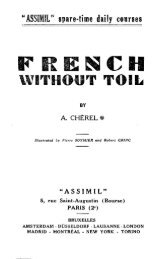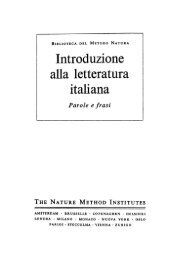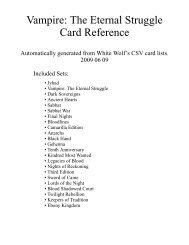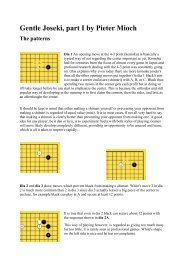Plains Cree: A Grammatical Study - Computer Science Club
Plains Cree: A Grammatical Study - Computer Science Club
Plains Cree: A Grammatical Study - Computer Science Club
Create successful ePaper yourself
Turn your PDF publications into a flip-book with our unique Google optimized e-Paper software.
14 [TRANS. AMER. PHIL. SOC.<br />
represented by two dimensions of the diagram.<br />
Figure 2 (which ultimately derives from figure 1) may<br />
be interpreted to reflect the wide and narrow meanings<br />
of the non-obviative category. It purposely excludes<br />
the combinations of the non-third categories and the<br />
direction of action among them.<br />
2.02. Animate Obviative and Inanimate Plural<br />
Throughout the grammar of <strong>Cree</strong>, the inanimate<br />
(proximate) plural category and the animate obviative<br />
category (number-indifferent) show the same forms.<br />
This identity"5 is seen in the inflection of nouns for<br />
number-obviation (3.3) as well as in the independent<br />
forms of the verb where a direct contrast of gender<br />
exists; i.e. in the obviative forms of the transitive<br />
verbs with animate or inanimate goal (TA, TI) and of<br />
the intransitive verbs with animate actor (AI); and<br />
in the plural forms of the intransitive verbs with<br />
inanimate actor (II). In all these paradigms, the<br />
inanimate plural and the animate obviative are both<br />
marked by the ending -(w)a.<br />
Such a similarity may of course be accidental, just<br />
as the number-indifference of the <strong>Cree</strong> (animate)<br />
obviative is due to the merger, in this position in<br />
<strong>Cree</strong>, of Proto Algonquian *h and *1; thus, the <strong>Cree</strong><br />
ending -a (morphophonologically /ah/) corresponds<br />
to the Proto Algonquian (obviative) singular ending<br />
*-ali as well as to the (obviative) plural ending *-ahi.<br />
But if such a development were the cause of the<br />
identity, it would have to antedate Proto Algonquian,<br />
for even there the inanimate (proximate) plural and<br />
the animate obviative singular are marked by the<br />
same ending, *-ali.<br />
That the identity cannot be reduced to historical<br />
accident (at least not of such superficiality) is evident<br />
from the inflectional paradigms of pronouns. In<br />
addition to the standard nominal paradigm (4.3)<br />
there are two exclusively pronominal paradigms both<br />
of which show the same identity in spite of great<br />
differences of phonological shape. One (4.1) uses the<br />
ending -hi for both these categories, another (4.2)<br />
eha.16<br />
If we rule out accident as the cause of the identity<br />
of the animate obviative and the inanimate plural,<br />
we have to look for that semantic feature of <strong>Cree</strong><br />
which these categories have in common.17<br />
16 The usual term for such a phenomenon, syncretism, is avoided<br />
because of its directional implication (of a merger of previously<br />
separate categories).<br />
16 Ojibwa shows the same identity in pronouns which greatly<br />
differ from each other in phonemic shape; see Bloomfield, 1958:<br />
p. 43.<br />
17 The situation is somewhat reminiscent of the Indoeuropean<br />
case where in many languages the same endings occur in feminine<br />
singular and in neuter plural nouns, e.g. Latin via 'street': iuga<br />
'yokes'; Sanskrit send 'army': yugd 'yokes.' In some languages,<br />
moreover, neuter plural nouns take a singular verb form, e.g.<br />
Greek 7rrvra ,be 'all things change.'<br />
This state of affairs is taken as evidence for an earlier category<br />
of individual vs. collective, with the original collective giving rise<br />
WOLFART: PLAINS CREE<br />
This feature is yet to be found; however, there is at<br />
least one set of contexts where a link might con-<br />
ceivably be established.<br />
(a) In a series of coordinate nouns which function<br />
as the joint goal of a transitive verb,'8 animate<br />
obviative and inanimate plural are obviously<br />
indistinguishable:<br />
S 57-17 ... otinam ekwah ospikekanah ekwah<br />
take(TI 3) and rib (Op) and<br />
otihtihkosiwah . . .<br />
kidney (3')<br />
'he took the ribs and the kidneys'<br />
(b) If a noun which is usually inanimate functions<br />
as the goal of a transitive animate verb of speaking,<br />
the noun ending is completely ambiguous:<br />
S 8-43 soskwdc kahkiyaw kakwecimew<br />
right away all ask(TA 3-(3'))<br />
otdpacihcikanah.<br />
utensil (Op)<br />
'Without delay she asked all her utensils.'<br />
otdpacihcikanah is normally inanimate but here stands<br />
in construction with kakwecimew; for more details<br />
see 2.3.<br />
(c) Another aspect of the same phenomenon<br />
involves a set of transitive animate (TA) verb forms<br />
where an animate third person is the goal of an<br />
inanimate actor which is otherwise unspecific (5.83).<br />
Another set (5.61 ff.) also has an animate third person<br />
as goal and, in reference, has an obviative actor; in<br />
meaning and morphology, the actor is not specified.<br />
Thus, unless the situation is clarified by the context, a<br />
form like T60pll e-pZikiskwatikot may be interpreted<br />
as either 'it (0 or Op) speaks to him (3)' or 'he (3')<br />
speaks to him (3),' and this would be one meeting<br />
point of two seemingly disjunct categories.<br />
In fact, the situation just described may give rise<br />
to striking ambiguities. Thus, not only individual<br />
verbal forms or nominal-pronominal phrases but<br />
entire clauses may be truly ambiguous with respect<br />
to the categories under investigation, e.g.,<br />
T103p8. . . nandtohk ohi<br />
various this (0p/3')<br />
kikwasa 5hi e-wiyesimikot.<br />
something (Op/3') trick(TA (Op/3')-3)<br />
'all these various little things used to trick him.'<br />
to both the feminine singular and the neuter plural. Cf. Schmidt,<br />
1889; Meillet, 1937: pp. 291-292; and Lehmann, 1958; on the<br />
semantic aspects of this case see Kurylowicz, 1964, especially pp.<br />
205-206.<br />
The <strong>Cree</strong> data do not suffice to attempt a similar historical<br />
account (in spite of the stimulating suggestions of Warren Cow-<br />
gill and Francis Pardo), and any directional interpretations (split,<br />
merger, category re-alignment) have to be postponed.<br />
18 For the choice of verb type cf. 2.33.









